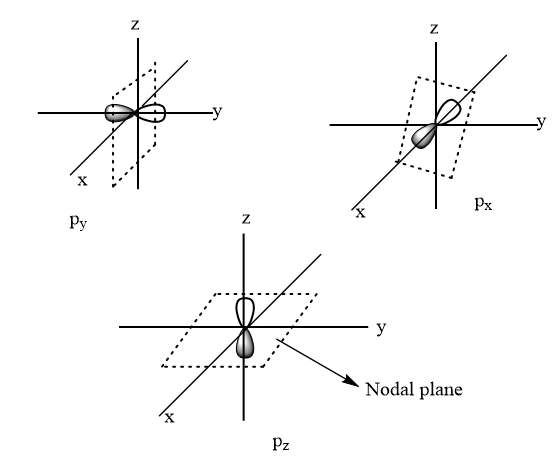
Number of nodal planes in $ 4p $ sub-orbit will be:
(A) $ 0 $
(B) $ 1 $
(C) $ 2 $
(D) $ 3 $
Answer
509.1k+ views
Hint: On the basis of the values of principal quantum number and azimuthal quantum number, we can determine that in which part of the suborbital, the probability of finding an electron is maximum or minimum.
Complete answer:
Node: It is a point, surface or a plane in which the probability of finding an electron is zero. These are categorized into two parts:
Radial nodes: It is also known as the nodal region and it is a spherical surface around the sub orbitals where the probability of finding electrons is zero. Its value is equal to $ n - l - 1 $ , where n is the principal quantum number and $ l $ is the azimuthal quantum number.
Angular nodes: It is also known as a nodal plane. It is a plane around the nucleus where the chances for finding an electron is zero. Its value is equal to azimuthal quantum number $ l $ .
The major concept in quantum mechanics is that the electrons show both wave as well as particle nature and the nodal planes around the nucleus indicate the wave nature of electrons i.e., if there are no electrons present then there would be no amplitude of vibration.
For $ 4p $ suborbital,
The value of principal quantum number $ n = 4 $
So, the value of azimuthal quantum number $ l $ lies between $ 0 $ to $ n - 1 $
$ \Rightarrow l = 0{\text{ to }}4 - 1 $
$ \Rightarrow l = 0{\text{ to }}3 $
We know that for p suborbital, $ l = 1 $
Hence, the number of nodal planes for $ 4p $ suborbital $ = 1 $

Thus, option (B) is the correct answer.
Note:
It is important to note that the atoms or molecules with few numbers of nodal planes are comparatively stable that those who have large numbers of nodal planes because the atoms with greater nodal planes are very unstable and reactive. Also, the number of nodal planes in a molecule directly varies with the free energy associated with the group of bonded atoms.
Complete answer:
Node: It is a point, surface or a plane in which the probability of finding an electron is zero. These are categorized into two parts:
Radial nodes: It is also known as the nodal region and it is a spherical surface around the sub orbitals where the probability of finding electrons is zero. Its value is equal to $ n - l - 1 $ , where n is the principal quantum number and $ l $ is the azimuthal quantum number.
Angular nodes: It is also known as a nodal plane. It is a plane around the nucleus where the chances for finding an electron is zero. Its value is equal to azimuthal quantum number $ l $ .
The major concept in quantum mechanics is that the electrons show both wave as well as particle nature and the nodal planes around the nucleus indicate the wave nature of electrons i.e., if there are no electrons present then there would be no amplitude of vibration.
For $ 4p $ suborbital,
The value of principal quantum number $ n = 4 $
So, the value of azimuthal quantum number $ l $ lies between $ 0 $ to $ n - 1 $
$ \Rightarrow l = 0{\text{ to }}4 - 1 $
$ \Rightarrow l = 0{\text{ to }}3 $
We know that for p suborbital, $ l = 1 $
Hence, the number of nodal planes for $ 4p $ suborbital $ = 1 $

Thus, option (B) is the correct answer.
Note:
It is important to note that the atoms or molecules with few numbers of nodal planes are comparatively stable that those who have large numbers of nodal planes because the atoms with greater nodal planes are very unstable and reactive. Also, the number of nodal planes in a molecule directly varies with the free energy associated with the group of bonded atoms.
Recently Updated Pages
The number of solutions in x in 02pi for which sqrt class 12 maths CBSE

Write any two methods of preparation of phenol Give class 12 chemistry CBSE

Differentiate between action potential and resting class 12 biology CBSE

Two plane mirrors arranged at right angles to each class 12 physics CBSE

Which of the following molecules is are chiral A I class 12 chemistry CBSE

Name different types of neurons and give one function class 12 biology CBSE

Trending doubts
What is 1s 2s 2p 3s 3p class 11 chemistry CBSE

Discuss the various forms of bacteria class 11 biology CBSE

Explain zero factorial class 11 maths CBSE

An example of chemosynthetic bacteria is A E coli B class 11 biology CBSE

Name the metals and nonmetals in the first twenty class 11 chemistry CBSE

Which one of the following is not a method of soil class 11 biology CBSE




